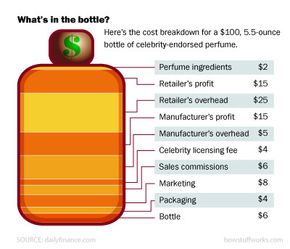Launching a New Perfume: Mixing It Up and Dousing the Public
Once the ingredients for the proposed perfume are assembled, the next step is mixing. The perfumer writes instructions for mixing the smells in different ratios, which technicians do in company labs [source: Turin]. One version might smell mostly like coconut, while another might be heavier in chili-lime. By choosing chemicals with different evaporation rates, the perfumer can control what you smell first, second and so on. Does a Thai sunrise smell like papaya, then pepper, or does the morning start out spicy?
The perfume house makes 10 to 100 versions of the perfume, which specialists smell and screen [source: Turin]. The best go to Gucci.
Advertisement
Gucci smells the attempts of the fragrance houses and dismisses those it thinks have missed the point of a Thai sunrise. From the rest, it asks for modifications, perhaps liking version No. 3, but finding the coconut too sweet.
The fragrance houses rework their perfumes. They swap in ingredients that are maximally economical, long lasting and safe. They test on skin, trying to maintain the smell's shape: If the perfume smells of fruit, then spice, ghost notes of fruit should remain even as the spice is taking over. The perfume may need three chemicals for the fruit smell -- one to evaporate quickly, one to stay longer and one to hang on for dear life [source: Sell]. The perfume houses test on consumers, comparing ratings for their perfume to a top-selling perfume. The numbers and the perfume go to Gucci.
Gucci chooses a fragrance and one lucky perfume house wins a contract. The winner sells the fragrance concentrate to Gucci at an agreed-upon price until the perfume goes out of production. The perfume house sends the concentrate to Gucci in up to 1-ton drums (0.9 metric tons) [source: Sell]. No one but the perfumer and her colleagues knows the exact formula, not even Gucci.
